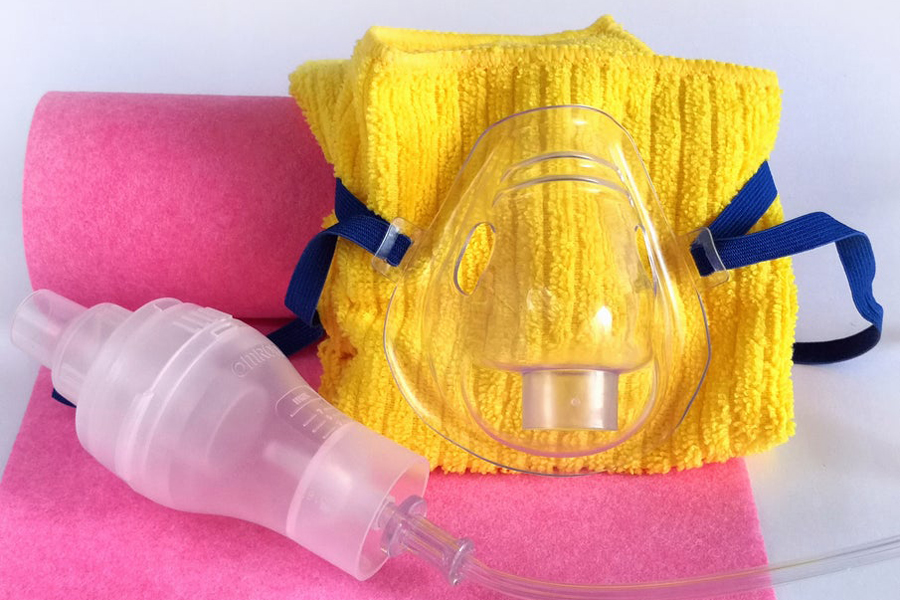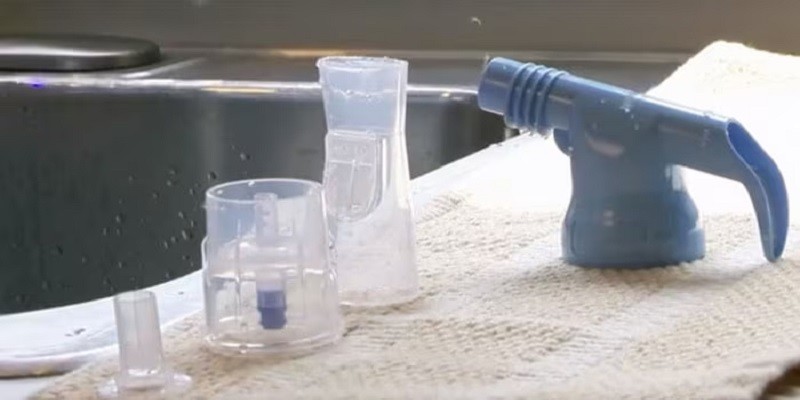To clean a nebulizer, start by disassembling the parts and washing them with warm soapy water. Rinse thoroughly and allow to air dry before reassembling.
Why Cleaning Your Nebulizer Is Important
Regularly cleaning your nebulizer is crucial to ensure its effectiveness and prevent the buildup of bacteria and germs. To clean a nebulizer properly, follow these steps.
Importance Of Regular Cleaning For Optimal Efficiency
Regular cleaning is essential for maintaining the optimal efficiency of your nebulizer. By cleaning your nebulizer regularly, you ensure that it functions properly, delivers medication effectively, and remains in good condition for a longer period of time. Cleaning your nebulizer not only guarantees the effectiveness of the treatment but also helps to prevent any potential risks or complications.
Here’s why cleaning your nebulizer is important:
- Removes build-up: Over time, residue and build-up can accumulate in your nebulizer, obstructing the airflow and reducing its efficiency. Regular cleaning helps to remove these deposits, ensuring that the medication is delivered evenly and effectively.
- Prevents contamination: Nebulizers come into contact with bacteria, germs, and other microorganisms during use. If not cleaned properly, these contaminants can pose a risk of infection or respiratory issues, especially for individuals with compromised immune systems. Cleaning your nebulizer helps to eliminate these harmful particles, reducing the risk of infections.
- Extends lifespan: Proper cleaning and maintenance significantly extend the lifespan of your nebulizer. Regular cleaning helps to prevent corrosion and damage caused by residue build-up or stagnant moisture, which can lead to mechanical issues or reduced performance over time.
- Enhances medication delivery: A clean nebulizer ensures that medication is delivered correctly and efficiently. By removing any residue or blockages, the nebulizer can effectively convert the liquid medication into a fine mist for inhalation, maximizing its therapeutic benefits.
- Improves treatment outcomes: Cleaning your nebulizer regularly helps to maintain consistent performance and ensure accurate dosage delivery. This, in turn, enhances the effectiveness of your treatment and improves overall health outcomes.
- Prevents odor and bad taste: Neglecting to clean your nebulizer can result in the development of unpleasant odors or tastes. Cleaning helps to eliminate any lingering traces of medication, preventing these unwanted effects and ensuring a more pleasant experience during treatment.
- Reduces the risk of allergens: Nebulizers can accumulate allergens such as dust, pollen, or pet dander. Cleaning your nebulizer removes these allergens, reducing the risk of triggering allergic reactions or respiratory discomfort during inhalation.
Risks Of Not Cleaning The Nebulizer Properly
Not cleaning your nebulizer properly can lead to several risks and complications. Failing to maintain a clean nebulizer can:
- Compromise treatment effectiveness: A dirty nebulizer can hinder the proper delivery of medication, reducing its effectiveness and potentially diminishing the therapeutic benefits of the treatment.
- Increase the risk of infections: Bacteria, germs, and other harmful microorganisms can thrive in a dirty nebulizer. If not cleaned properly, these pathogens can be inhaled, increasing the risk of respiratory infections or exacerbating existing respiratory conditions.
- Cause blockages or malfunctions: Accumulated residue or debris can block the small openings or vents in the nebulizer, obstructing the airflow and impacting its performance. This can lead to uneven medication delivery, reduced dosage accuracy, or even complete equipment malfunction.
- Create unpleasant experiences: Neglected cleaning can result in foul odors or bad tastes, making the treatment experience uncomfortable or even unbearable. This can discourage individuals from adhering to their treatment plan and compromise overall health outcomes.
- Compromise device lifespan: Lack of proper cleaning and maintenance can shorten the lifespan of your nebulizer. Residue build-up and corrosion caused by neglect can lead to mechanical issues or damage, requiring costly repairs or the need for a replacement sooner than expected.
It is crucial to regularly clean your nebulizer to maintain its effectiveness, prevent potential risks, and ensure optimal treatment outcomes. By incorporating a simple cleaning routine into your nebulizer usage, you can enhance the longevity of your device and promote your overall well-being.

Credit: news.lifewellnesshealthcare.com
Step-By-Step Guide To Cleaning Your Nebulizer
Properly clean your nebulizer with this easy-to-follow step-by-step guide. Keep your nebulizer in optimal condition and enjoy effective respiratory treatments.
Cleaning your nebulizer regularly is important to ensure its effectiveness and prevent the buildup of harmful bacteria. Follow this step-by-step guide to clean your nebulizer efficiently:
Gather Necessary Supplies:
- Dish soap or mild detergent
- Clean, warm water
- Clean cloth or towel
- Small brush (soft-bristled)
- Clean, dry container for air drying
Disassemble The Nebulizer:
- Start by switching off and unplugging the nebulizer. Ensure it is completely disconnected from any power source.
- Carefully detach the mask or mouthpiece from the nebulizer chamber.
- Remove the medicine cup from the nebulizer chamber and detach any additional parts such as the tubing or air filter, depending on the type of nebulizer you have.
Clean The Individual Parts:
- Rinse the mask, mouthpiece, and medicine cup with warm water to remove any residual medication.
- Place these parts in a mixture of warm water and a few drops of dish soap or mild detergent.
- Using a soft-bristled brush, gently scrub the parts to remove any residue or debris. Pay special attention to any hard-to-reach areas.
- Thoroughly rinse the parts with clean water to remove any soap or detergent residue.
- If needed, use a clean cloth or towel to wipe away any excess water.
Rinse And Dry The Parts:
- Once the individual parts are cleaned, rinse them again with clean water to ensure all soap or detergent residue is removed.
- Shake off any excess water and place the parts on a clean towel or in a clean container to air dry.
- Allow the parts to dry completely before reassembling the nebulizer.
Reassemble The Nebulizer:
- Start by attaching the medicine cup back into the nebulizer chamber, making sure it fits securely.
- Reattach any additional parts that were removed, such as the tubing or air filter.
- Connect the mask or mouthpiece back onto the nebulizer chamber.
- Ensure all connections are tight and secure before using the nebulizer again.
Cleaning your nebulizer regularly will help maintain its functionality and ensure optimal performance. Refer to the manufacturer’s instructions for any specific cleaning recommendations or additional steps. By following this step-by-step guide, you can continue to use your nebulizer safely and effectively.
Additional Tips For Cleaning And Maintenance
Keeping your nebulizer clean is essential for proper functioning and maintenance. Follow these additional tips to ensure thorough cleaning: rinse with warm water after each use, disinfect with a vinegar solution or mild dish soap, air dry on a clean towel, and store in a clean, dry place.
Nebulizers are essential medical devices for delivering medications directly into the respiratory system. To ensure they function properly and provide effective treatment, regular cleaning and maintenance are crucial. In this section, we will provide you with additional tips on how to clean and maintain your nebulizer for optimal performance.
Recommended Cleaning Frequency:
- Clean your nebulizer after each use to prevent the accumulation of bacteria and other contaminants.
- Disassemble the nebulizer into its individual parts for thorough cleaning.
Using Distilled Water For Cleaning:
- Always use distilled water when cleaning your nebulizer.
- Distilled water is free from impurities that can clog the device and affect its performance.
- Avoid using tap water, as it may contain minerals or chemicals that can damage the nebulizer or compromise the effectiveness of the medication.
Storing The Nebulizer Properly To Prevent Contamination:
- After cleaning, allow the nebulizer parts to air-dry completely before storing.
- Place the dry parts in a clean, dry storage container.
- Avoid storing the nebulizer in areas prone to dust or humidity.
- Make sure the storage container is kept in a cool and dry place to prevent mold or bacterial growth.
Remember, proper cleaning and maintenance ensure the nebulizer functions optimally and delivers medications effectively. By following these additional tips, you can maintain the longevity and effectiveness of your nebulizer, allowing you to breathe easier and experience better respiratory health.
Frequently Asked Questions On How To Clean A Nebulizer?
How Do You Clean A Nebulizer After Every Use?
To clean a nebulizer after each use, follow these steps: 1. Disassemble the nebulizer according to the manufacturer’s instructions. 2. Rinse the parts with warm water and mild detergent. 3. Let the parts air dry on a clean towel. 4.
Store the nebulizer in a clean and dry place until the next use.
Can You Clean Nebulizer With Tap Water?
No, you should not clean a nebulizer with tap water.
How Much Vinegar Do You Use To Clean A Nebulizer?
Clean a nebulizer using vinegar by adding an equal amount to the water in the nebulizer cup.
What Happens If Water Gets In Nebulizer Tubing?
Water in the nebulizer tubing can affect the effectiveness of the treatment and may cause equipment malfunction.
Conclusion
Proper cleaning of a nebulizer is essential for maintaining its functionality and ensuring an effective treatment experience. By following the steps outlined in this blog post, you can easily clean your nebulizer and keep it in good condition for future use.
Remember to disassemble the nebulizer and wash the individual components thoroughly with warm, soapy water. Allow them to air dry completely before reassembling the device. It’s also important to clean the mouthpiece or mask after each use to prevent the build-up of bacteria or mold.
By incorporating regular cleaning into your nebulizer routine, you can feel confident in the cleanliness and effectiveness of your device. So, take the time to clean your nebulizer properly and enjoy hassle-free respiratory treatments whenever needed.
Editorial Recommendations:
- How To Clean A Nespresso Machine?
- How To Clean Nespresso Machine With Vinegar?
- How To Clean Nespresso Milk Frother?
Last Updated on October 19, 2025 by Marjorie R. Rogers, MA (English), Certified Consultant






